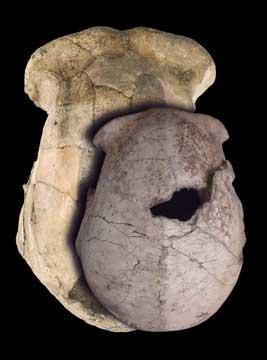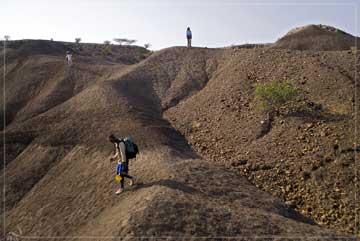|
FEATURE
Controversy in the Cradle of Humankind
Kathryn Hansen
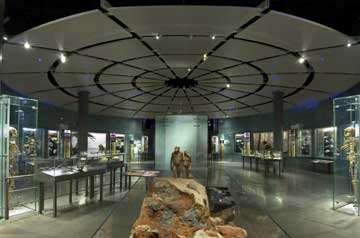 Copyright Denis Finnin/AMNH |
| The History of Human Evolution section of the new Anne and Bernard Spitzer Hall of Human Origins at the American Museum of Natural History in New York City features some key early hominins. In its center stand an Australopithecus couple walking side-by-side. |
In Kenya, the so-called cradle of humankind where some of the most famous fossils of early humans have been found, a battle has been brewing over what has been a more characteristically American controversy: evolution versus creationism, and science versus religion. At the center of the debate is the highlight of the National Museums of Kenya Nairobi Museum’s collection, a 1.6-million-year-old Homo erectus skeleton called Turkana Boy. Found two decades ago near the shores of northern Kenya’s Lake Turkana by Kamoya Kimeu, a member of the famed anthropologist Richard Leakey’s research team, this 1.6-meter-tall preteen fossil is one of the most complete hominin fossils ever found, and clearly illustrates human evolution, scientists say.
One Christian leader, who says he represents close to one-sixth of the Kenyan population, disagrees, however. He is taking on scientists in a fight over a display called the Origins of Man, the most famous and valuable collection in the Nairobi Museum, which highlights human evolution. Thus the battle ensues.
While this political war is waged, scientists are going about their business excavating all around East Africa, finding more and more fossils that are bringing to light the path of early human evolution. In fact, just this year, researchers on a field expedition in northern Ethiopia uncovered a hominin jawbone that may be a missing link between the famous Lucy fossil and her ancestors. And in August, a different group of researchers published a report about yet another find, which suggests the human family tree is more of a bush than previously thought, and provides more evidence that different species of hominins coexisted at various points in time.
Evolution on display
For the past couple of years, the National Museums of Kenya have been undergoing a multi-million-dollar renovation, sponsored by the European Union. Originally planned to reopen in June, the museum is now set to open sometime this fall, perhaps in November, says a spokesperson at the public relations firm representing the museum. When the revitalization program is complete, Turkana Boy is scheduled to take center stage in the Origins of Man display. In addition to Turkana Boy, the museum hosts more than 160,000 fossils spanning the past 200 million years, including other hominins — such as a 4-million-year-old Australopithicus anamensis, the first-known hominin to undisputedly walk upright — as well as dinosaurs, plants and other animals.
|
|
| In 2000 near Kenya’s Lake Turkana, a team of researchers discovered two new hominin skulls that are changing the view of the human family tree. The 2000 discovery suggests that several species of hominins coexisted in the same region in the past, and that ancient hominins varied extensively in size between males and females. The particularly small Homo erectus skull is shown above with another H. erectus skull from the Olduvai Gorge site in Tanzania to demonstrate the size variation of the species. Paleoanthropologist Meave Leakey and members of her field crew painstakingly excavated the Homo erectus and Homo habilis skulls. | |
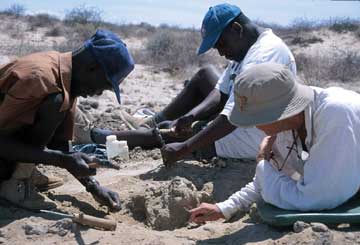 Koobi Fora Research Project/L.N. Leakey |
But the renovation and exhibit have not come about without protest. Last year, Bishop Bonifes Adoyo, head of Christ is the Answer Ministries (CITAM) in Nairobi, Kenya, called for a boycott of the exhibit, and for the museum to remove the fossil collection from display and relegate it to a backroom somewhere. He also suggested that a sign be displayed that explains that evolution is just one explanation of how humans came to be, according to a story in London’s Daily Telegraph in 2006. “The Christian community here is very uncomfortable that [Richard] Leakey and his group want their theories presented as fact,” Adoyo told the Telegraph. “Our doctrine is not that we evolved from apes, and we have grave concerns that the museum wants to enhance the prominence of something presented as fact which is just one theory,” he said.
Adoyo claims that CITAM represents some 6 million residents of Kenya, who, as “Christians who believe God created us,” are all being negatively affected by the claim that “man evolved from apes,” he said. A museum display showing that modern humans are related to Turkana Boy creates “a big weapon against Christians that’s killing our faith” and is dangerous to youths who may “start believing we evolved from these apes,” Adoyo told Agence France Presse in September 2006. “This is not the truth,” he said.
Leakey, currently a professor at Stony Brook University in New York who still works in Kenya and was formerly director of the National Museums in Kenya, has been actively fighting Adoyo and his constituents, calling Adoyo’s statements “the most outrageous comments I have ever heard,” according to the Telegraph. “Their theories are far, far from the mainstream on this. They cannot be allowed to meddle with what is the world’s leading collection of these types of fossils,” he said.
Furthermore, Leakey said, considering how important this fossil collection is, “the National Museums of Kenya should be extremely strong in presenting a very forceful case for the evolutionary theory of the origins of mankind.” The museum “must be at the forefront of this branch of science.”
Although the National Museums of Kenya has been reticent to get involved in this very public debate, it is moving forward with the renovations and keeping the exhibits as planned, according to the museum’s public relations firm. The European Union, which has funded much of the renovation, has said that the Kenyan museum can do whatever it wants regarding the displays, and that they will not get involved in the religious debate. This renovation marks the first since the museum first opened in 1930. It also involves implementing new legal reforms designed to protect Kenya’s heritage that the Kenyan parliament passed in 2005. These reforms involve better documenting display items at the museums, revitalizing conservation programs and expanding outreach programs, while also implementing international heritage conventions and protocols.
The African Cradle
East Africa indeed has much heritage to protect, as the region has been a hotspot for paleoanthropologists trying to understand the evolutionary relationships between early hominins since at least the 1950s.
In 2000, just east of Lake Turkana where Turkana Boy was uncovered in 1984, Meave Leakey, Richard’s wife and a prominent paleoanthropologist in her own right, and colleagues discovered two hominin fossils that may turn the traditional human family tree on its side, as the team reported in Nature, Aug. 9, 2007. They uncovered two skull fossils, one of Homo habilis dated to 1.44 million years old and one of Homo erectus dated to 1.55 million years old, that the team says indicates that the two species lived side by side for a considerable amount of time.
Previously, researchers had suggested that H. habilis, which was thought to have existed between 2.33 million years ago and 1.65 million years ago, was an ancestor to H. erectus, which was thought to have lived in Africa from 1.9 million to 1.0 million years ago. The new finding of such a young H. habilis fossil suggests that the two species coexisted in the same area for at least half a million years, and calls into question whether these hominins evolved from one another, the researchers wrote. The discovery is already sparking debate in the paleoanthroplogy community, which only the discovery of more fossils can settle. The finding demonstrates how significant this region is for human evolution.
North of Kenya in Ethiopia, the Afar Depression has also proved to be a hominin hotspot. Here, at a location where three tectonic plates are actively spreading apart, researchers have found many different early human ancestors that span up to 6 million years, including the famous Lucy, a 3.2-million-year-old Australopithecus afarensis specimen, discovered by Donald Johanson and colleagues in 1974. The region has also revealed the earliest definitive hominin Ardipithecus kadabba, which is 5.8 million years old, and examples of the earliest known members of our own species, Homo sapiens, estimated to be 160,000 years old.
And researchers continue to uncover new finds from the Afar region. Earlier this year, a team led by Yohannes Haile-Selassie of the Cleveland Museum of Natural History unearthed hominin jaws that date to between 3.8 million and 3.5 million years old. “These specimens sample the right time to look into the relationship between Australopithecus anamensis and Australopithecus afarensis,” two previously known species, Haile-Selassie said, according to a press release. The fossils “will play a major role in testing the ancestor-descendant hypothesis,” he said. Like the relationship between H. habilis and H. erectus, researchers have presumed that A. anamensis is the ancestor of A. afarensis. These new fossils, Haile-Selassie said, test this hypothesis, further clarifying the evolving story of human evolution.
|
|
| During the 2007 field season in the Woranso-Mille project study area in Ethiopia, pictured here, a team led by paleoanthropologist Yohannes Haile-Selassie discovered fossils that may tie together two early hominins, Australopithecus afarensis and Australopithecus anamensis. | |
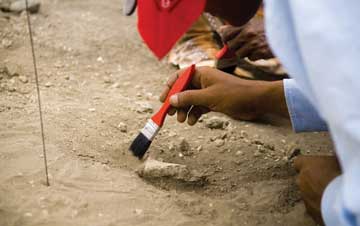 Copyright The Cleveland Museum of Natural History |
|
| Paleoanthropologist Yohannes Haile-Selassie excavated the lower jaw of an early hominin in Ethiopia earlier this year. The team found other jaw parts and teeth by sifting through the dirt for days. |
As it is difficult for paleoanthropologists to elucidate our ancestors’ past, museum officials also face a challenging task in determining how to display this history to the public, as the recent battle in Kenya highlights. This problem is hardly limited to East Africa, however, as museums in the United States face their own set of controversies.
On the U.S. front
In early August, the Ethiopian Natural History Museum unceremoniously bid farewell to Lucy, which was secretly flown to the United States under the cover of darkness and amid some controversy, according to an Aug. 7 Associated Press story. Although museum officials had been planning for awhile to loan Lucy to museums across the United States, her abrupt departure from the country surprised many of Ethiopia’s citizens. Lucy was set to begin a U.S. tour starting in Texas at the end of August.
The tour itself is also quite controversial, partially because many researchers worry that the specimen is too fragile to travel. The Smithsonian Institution, for example, has objected to the six-year tour on the basis of Lucy’s fragility, according to the Associated Press story. “Quite simply, the Smithsonian position is that the fossil Lucy, one of the most important specimens of its kind, is too fragile to go on public tour,” National Natural History Museum spokesman Randall Kremer told the Associated Press. Even in Ethiopia, the real Lucy fossil has only been displayed twice, while most of the time visitors instead see a replica.
According to an Aug. 10 Associated Press story, Richard Leakey called the tour a form of prostitution: The Ethiopian government will receive proceeds from Lucy’s tour, which it says it will use to upgrade museums. That’s quite a gamble with an irreplaceable fossil, Leakey said, especially considering it is almost certain that the valuable fossil will get damaged, no matter how careful people are in the transport.
Other people, however, including curators at the Houston Museum of Natural Science where the fossil was set to make its American debut Aug. 31, say that even though they share the Smithsonian’s concerns, Lucy will be taken care of. The fossil is so culturally significant, said the U.S. State Department, which approved the travel, that her display is a matter of national interest.
Meanwhile, at the American Museum of Natural History in New York City, evolution is also on display in a new exhibit. So far, the new display in the Hall of Human Origins has received only minor complaints, says Ian Tattersall, a paleoanthropologist at the museum. And those complaints stem from a small display at the end of the exhibit in which various well-known scientists discuss why they do not find evolution at variance with their religious beliefs, he says.
Between 4 million and 5 million people a year visit the museum and the new exhibit has been consistently packed since it opened in February, Tattersall says. “The complainers want to know why we are introducing religion into a science exhibit and, of course, this is a legitimate question,” he says. Scientific and religious concepts are “fundamentally different in nature and serve entirely different aspects of the human thirst for knowledge,” he says. “I see no need for conflict between them; this is not an either/or situation.” Not here in the United States, or in Kenya, Ethiopia or any other part of the world.

 Subscribe
Subscribe

